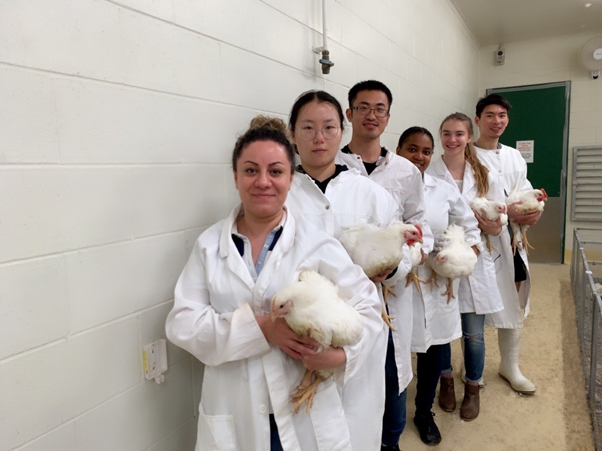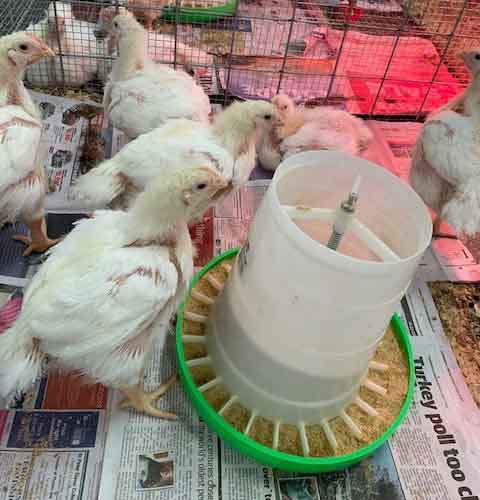Energy saving effects of multi-enzyme super-dosing in meat chicken.
27 July 2020
A new SAFS research project aimed at enhancing nutrient utilization, growth performance, gut functionality and meat quality of broiler chickens through multi-enzyme super-dosing, Co-funded by Bioproton Pty. Ltd. and School of Agriculture and Food Science, University of Queensland.
The project was led by Dr Elham Assadi Soumeh, whose research focus is enhancing nutrient utilisation efficiency, meat quality, and gut health and functionality in meat chicken production systems.

a multi-enzyme, in broiler diets
The ability of efficient multi-enzyme solutions to improve feed digestibility and growth performance has been well-known. A multi-enzyme helps the birds hydrolyse indigestible fractions of the feed where the bird does not produce these specific enzymes for those fractions. Multi-enzymes also improve the digestibility of the digestible fractions where the bird’s own endogenous enzyme production is not sufficient or produced fast enough as the digesta passage rate is high in birds.
Multi-enzyme super-dosing, using an enzyme cocktail in a much higher dose rate (almost 3 fold) has recently been introduced into the animal feed industry. In commercial poultry production, feed formulations already provide all the required nutrients, often-in higher concentrations than actual demands to avoid nutrients deficiency; this is expensive and wasteful. Multi-enzyme super-dosing may make nutrients more readily available, which could lead to lower levels of these nutrients being incorporated into broiler diets, making the diets precise and less expensive. The objective of the study was therefore to determine energy saving effects of Natuzyme super-dosing in broiler chicken production (defining matrix value for high dose rate of Natuzyme).
To evaluate the energy saving effects of Natuzyme at different dose rates, a broiler chicken grow-out trial was conducted using a total of 576 day old, mixed-gender broiler chicken (ROSS 308). Day-old broiler chicken were purchased from a commercial hatchery, transported to QASP and, located in the Isolation Shed at the QASP facility, Gatton Campus, University of Queensland. The birds were fed with experimental diets including a standard corn-soybean diet with 3 metabolisable energy levels (standard/no reduction, -150kcal/kg and -200kcal/kg) which was cross-factored with 4 Natuzyme inclusion levels (0, 350, 700, and 1000 g/ton) to identify matrix values to be used in feed formulation practices if Natuzyme is supplemented in higher doses. Birds and feed were weighed weekly and feed intake, daily gain, and feed efficiency were calculated for starter, grower, finisher, and overall growth period. At the end of the trial, one bird was sampled from each cage for further laboratory analyses on organ development and carcass composition, meat quality, bone minerals, nutrient digestibility, gut morphology, and gut microbial profile.

As expected, reducing the dietary energy content (without Natuzyme), decreased feed conversion ratio as the birds followed the glucostatic theory to regulate their feed intake. The birds compensated for the reduced energy content by increasing their feed consumption resulting in a much higher feed cost.
Natuzyme super-dosing tended to increase the birds’ final body weights and average daily gain, however, it had no effects on daily feed intake or feed conversion ratio when compared to the control diets containing the correct amount of energy. In fact, the diets with -150 kcal reduced energy content at all three doses of Natuzyme had similar high body weights and average daily gains as the control diet. This indicates that birds fed diets with lower energy levels enhanced with Natuzyme perform to the same levels of those birds fed the standard commercial diet.
Carcass composition results showed that birds on lower energy content tend to have bigger breasts and less abdominal fat. This could be linked to the protein intake per day. In the reduced-energy diets, the protein:energy ratio was higher and a higher protein intake results in a bigger breast muscle.
Meat quality was evaluated by Prof Louwrens Hoffman from QAAFI. The results showed that meat quality traits were not affected by either energy content, Natuzyme dose rates or their interactions; this indicates that the chicken meat will still be “chicken” as perceived by the consumer. Calcium and phosphorous content in the tibia bone was increased by Natuzyme dose rates.
Nutrient digestibility was calculated for N and organic matter in the diets with increasing Natuzyme dose rates only. Natuzyme dose rate increased N and organic matter digestibility linearly with the highest at 700 g/t Natuzyme. Natuzyme supplementation at 1000 g/t did not improve the digestibility of N and organic matter further. It seems that Natuzyme dose rates of 350 and 700 g/t significantly improves nutrient digestibility, and decreases excreted N. Gut morphology and pH was studied in birds received increasing doses of Natuzyme only. Natuzyme tended to increase the villi’s height in the duodenum and jejunum. This increased villi heights would increase the surface area available for nutrient absorption and would have been responsible for the improved nutrient digestibility.
Additionally, the gut microbial profile was determined in the caecum content of the birds which were fed with Natuzyme increasing dose rates only and showed that there were no differences; the birds had similar Richness and Evenness. Examining the alpha diversity parameters for all samples using these rank tests, it was confirmed that the digesta sampled contained a highly diverse microbiota, which was similar in abundance across all diets. Core microbiota analysis showed that genus Romboutsia and the microorganism Ruminococcus gauvreauii were identified in diets containing 700 g/t Natuzyme. Ruminococcus have been reported to be positively associated with feed efficiency in chickens. The genus Ruminococcus is known for its ability to degrade complex carbohydrates and thus may have contributed to an improved degradation of non-starch polysaccharides, as well as stimulating fatty acids, amino acids, and vitamins synthesis – also resulting in improved digestibility of the experimental diets.
In conclusion, based on the outcomes of this study, Natuzyme at a dose rate of 700 g/t could be used in feed formulation saving 150 kcal of metabolizing energy. This can replace the current matrix value recommendation of 70 kcal/kg energy savings with Natuzyme supplemented at commercial dose rate (350 g/t) and result in substantial savings in feed cost for the poultry industry.


Dr Elham (Ellie) Assadi Soumeh (researcher profile: http://researchers.uq.edu.au/researcher/17116) is a lecturer in Animal Science and Production within the School of Agriculture and Food Science. Her research background is in monogastric animal nutrition -poultry and swine, focusing on different industry-focused and fundamental research portfolios within the area of monogastric animal nutrition and production e.g. nutrient requirements and metabolism, gut health, microbiome, and functionality, nutrigenomics and nutritional strategies and management.

Prof Louw Hoffman (researcher profile: https://qaafi.uq.edu.au/profile/4974/louw-hoffman) is an animal scientist specializing in meat science with extensive experience and knowledge in the area of meat quality. He has published more than 370 peer-reviewed papers and 33 PhD and 145 MSc students have completed their studies under his guidance.
